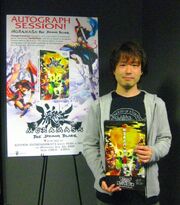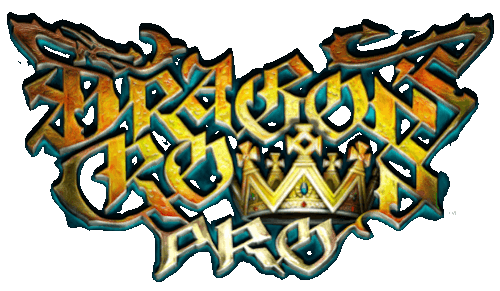No edit summary |
|||
| Line 35: | Line 35: | ||
==Games in which Kamitani has participated== |
==Games in which Kamitani has participated== |
||
| − | *1991 - [[Wikipedia:Hillsfar|Advanced Dungeons & Dragons: Hillsfar]] (Famicom) |
+ | *1991 - [[Wikipedia:Hillsfar|''Advanced Dungeons & Dragons: Hillsfar'']] (Famicom) |
| − | *1993 - ''Saturday Night Slam Masters'' (arcade) |
+ | *1993 - [[Wikipedia:Saturday Night Slam Masters|''Saturday Night Slam Masters'']] (arcade) |
*1994 - ''Dungeons & Dragons: Tower of Doom'' (arcade) - planner |
*1994 - ''Dungeons & Dragons: Tower of Doom'' (arcade) - planner |
||
| − | *1996 - http://www.gamefaqs.com/snes/569353-bishoujo-wrestler-retsuden-blizzard-yuki-rannyuu ''Bishoujo Wrestler Retsuden: Blizzard Yuki Rannyuu''] ([[Wikipedia:Super Nintendo Entertainment System|Super Famicom]]) - character action |
+ | *1996 - [http://www.gamefaqs.com/snes/569353-bishoujo-wrestler-retsuden-blizzard-yuki-rannyuu ''Bishoujo Wrestler Retsuden: Blizzard Yuki Rannyuu''] ([[Wikipedia:Super Nintendo Entertainment System|Super Famicom]]) - character action |
*1997 - [[Wikipedia:Princess Crown|''Princess Crown'']] (Sega Saturn) - character design, director |
*1997 - [[Wikipedia:Princess Crown|''Princess Crown'']] (Sega Saturn) - character design, director |
||
*2006 - ''Fantasy Earth: Zero'' (Windows) - character design, director |
*2006 - ''Fantasy Earth: Zero'' (Windows) - character design, director |
||
Revision as of 05:33, 22 June 2014

George Kamitani in an autograph session for the Wii game Muramasa: The Demon Blade in 2009.
George Kamitani (神谷 GEORGE or its Katakana equivalent ジョージ), also known as Jouji Kamitani (神谷 盛治), is the founder and lead designer of Japanese video game developer Vanillaware. A native of Hiroshima Prefecture, Kamitani is the creator of cult titles Princess Crown, Odin Sphere, Grimgrimoire, and Muramasa: The Demon Blade. While his real name is George, he uses instead the Kanji "盛治" (normally read as Moriharu, Moriji or Seiji, but read in this instance as Jouji to approximate phonetically to George) as his preferred name in Japanese media.[1]
Kamitani's dream and that of Vanillaware's staff is to keep making games for as long as they can. He also wishes that Vanillaware grew to the point where he would not need to be the main person responsible for the company so that he could focus more on devoting to ideas that he finds interesteing to explorer.[2]
Background
As a child, Kamitani enjoyed movies, particularly those with special effects and dreamed of filming. However, he was unable to get a camera so he focused instead on video games. Kamitani has continued to work in the game industry since high school. The fantasy of the Norse mythology presented in NEC PC-8801 RPG game The Black Onyx impressed Kamitani. This was the first time that he saw anything related to fantasy. As such, it deeply affected the way Kamitami represents the fantasy worlds in his games.[3]
Kamitani got into the video game business when he was a senior high school student. One of his friends helped him to get a part-time job as a subcontractor for a video game company and Kamitani continued to work there while going to college until he graduated. As a subcontractor, Kamitani was a 2-D pixel artists for several Famicom games and as a programmer in some MSX games.[4] He convinced his parents into allowing him to work part-time by saying it would improve his math skills.
After graduating from college and moving from Hiroshima to Osaka, Kamitani joined Capcom around 1992 because he wanted to learn how to direct a game project. In Capcom, Kamitani was a subordinate of Yoshiki Okamoto,[1] producer of the original Street Fighter II. Akira "Akiman" Yasuda was also Kamitami's boss at Capcom's design department [5] It was in Capcom where he developed a profound attachment to 2D games as it was the height of 2D arcade games such as Capcom's Vampire, Alien vs. Predator and Dungeons & Dragons: Tower of Doom.[3] Kamitami worked in the last one and it had a lasting effect on his future works.[4] Kamatami's departament worked mostly on action side-scrolling games. He decided to left Capcom because he felt he would never be able to direct a game in the company due to the great amount of talented people that where there already.[6]
After his stay in Capcom, he joined a small game company invited by a former senior classmate and then went on to work freelance with several companies, such as Atlus, Racjin and Sony Computer Entertainment.[2] At the end of 1995, while working on Princess Crown, the development company went bankrupt, but thanks to a friend at Sega that introduced him to Atlus, the project was saved, an action for which he is still grateful to Atlus.[6] Atlus would repeat this feat with Dragon's Crown years later. Kamitani then joined Atlus Kansai and was very attached to the Princess Crown team, but, despite being critically critically acclaimed, Princess Crown was not a commercial success due to having been released at the end of Saturn's life cycle and staff that worked on it wasn't looked upon favorably. Atlus Kansai soon after closed. and the Osaka company Racjin took many of the team members, effectively dissolving the team that worked on Princess Crown.
Invited to Tokyo by Shigeo Komori, the scenario writer of Princess Crown, Kamitani went to work at Sony Computer Entertainment in confidential projects, where he unsuccessfully tried to do game planning. By 2001, Only Kamitani and Kentaro Ohnishi, current Vanillaware programmer, remained and were living in complicated conditions. With 32 years of age, Kamitami couldn't return to Osaka with no job, so he decided to stay in Tokyo. He got introduced to a job that made him became involved with Fantasy Earth: The Ring of Dominion, later Fantasy Earth: Zero, which with his involvement shifted the world theme from a conflict between humans and vampires thing into a more traditional fantasy setting.[6] A Square Enix game, it was a project that started with Enix prior to their merger with Squaresoft and from which Kamitani did not part on good terms with Square Enix after the company took the project from Kamitani and his staff. While working on Fantasy Earth: Zero, Kamitani met Hitoshi Sakimoto, the head of the company Basiscape which does the music for most Vanillaware games since Odin Sphere.[3]
It was in Tokyo where Kamitani founded the video game company Puraguru in 2002, which in 2004 would be renamed to Vanillaware, in order to produce games that he and his staff wanted to develop.[2] Kamitami consider his involvement in Fantasy Earth: Zero has his toughest and most stressing experience in the industry. Shigatake helped Kamitami with this project. Shigatake turned out to be and admirer of Princess Crown, so Kamitami convinced him to join his project.
Style, influences and inspiration
Kamitani is regularly the director and graphic designer for Vanillaware games. Kamitani regularly gives a lot of attention to food sequences in his games. According to him, this is because eating is one of the three human desires, and if someone eats, he is happy, so he tries to capture that sentiment.[3]
During his time in Capcom, Kamitani art style became influenced by the style of his then boss Akiman and fellow artists Kinu Nishimura and Bengus, who remain an inspiration for him.
The concept of raising your character to achieve different endings in Gainax video game Princess Maker 2 was the inspiration for Princess Crown, changing the raising section for fighting action. The RPG elements of Princess Crown were added because Sega needed RPGs for the Sega Saturn and when Kamitami presented the project and was questioned about the game being an RPG he answered affirmatively, so he talked with the two main programmers to make it an RPG.[6]
While working in several companies before starting his own, Kamitani developed his particular style by saving various visions of direction and expression that he wanted to take in the future.[4] After the development of Princess Crown he wanted to create a game that would apply this knowledge which ended up becoming Odin Sphere.
Kamitani's favorite real-time strategy game was StarCraft, which became the inspiration for GrimGrimoire.[7]
Dragon's Crown is a personal project for Kamitani, who had tried to pitch the game since 1998. At that time, his then employer, Atlus Kansai, closed doors and the project was left in the air.[8] The inspiration to make the game an online experience came from his time developing Fantasy Earth: Zero, with a similar concept to Dungeon Fighter Online.[2]
In Dragon's Crown, Kamitani deliberately exaggerated and cartoonified the character designs in order to make the game avoid being classified as a generic fantasy trope.[8]
Most Kamitani's games since Princess Crown have a female protagonist as the game's lead. According to Kamitani, this is because he loves the concept of a young girl confronting a huge monster.[7]
Games in which Kamitani has participated
- 1991 - Advanced Dungeons & Dragons: Hillsfar (Famicom)
- 1993 - Saturday Night Slam Masters (arcade)
- 1994 - Dungeons & Dragons: Tower of Doom (arcade) - planner
- 1996 - Bishoujo Wrestler Retsuden: Blizzard Yuki Rannyuu (Super Famicom) - character action
- 1997 - Princess Crown (Sega Saturn) - character design, director
- 2006 - Fantasy Earth: Zero (Windows) - character design, director
- 2007 - GrimGrimoire (PlayStation 2) - character draft, director, scenario
- 2007 - Odin Sphere - character design, director
- 2008 - Kumatanchi (Nintendo DS)
- 2009 - Muramasa: The Demon Blade (Wii) - character design, director
- 2001 - Grand Knights History (PlayStation Portable)
- 2013 - Dragon's Crown (PlayStation 3, PlayStation Vita) - character design, director
References
- ↑ 1.0 1.1 Okamoto, Yoshiki (2007-07-23). "Diary of July 2007". Archived from the original on 2009-07-08. Retrieved 2014-06-16.
- ↑ 2.0 2.1 2.2 2.3 Sheffield, Brandon (2009-08-03). "King of 2D: Vanillaware's George Kamitani". Gamasutra. Retrieved 2014-06-20.
- ↑ 3.0 3.1 3.2 3.3 "Jouji Kamitani Interview". Gamengai. Retrieved 2014-06-16.
- ↑ 4.0 4.1 4.2 Winkler, Chris (2007). "RPGFan Exclusive Interview #4: Jouji Kamitani". RPGfan. Retrieved 2014-06-21.
- ↑ Dragon's Crown Artworks (2013). Atlus. p. 57.
- ↑ 6.0 6.1 6.2 6.3 "ヴァニラウェアは命がけでゲームを作る会社――クリエイター神谷盛治氏・ロングインタビュー" (2013). 4Gamer.net. Retrieved on 2014-06-21.
- ↑ 7.0 7.1 Mielke, James (2007-06-27). "GrimGrimoire Developer Interviewed". 1up.com Retrieved 2014-06-08.
- ↑ 8.0 8.1 Kain, Erik (2013-08-16). "'Dragon's Crown' Developer George Kamitani Talks Gameplay, Controversy". Forbes. Retrieved 2014-06-07.
External links
- George Kamitani on Facebook
- King of 2D: Vanillaware's George Kamitani article at Gamasutra
